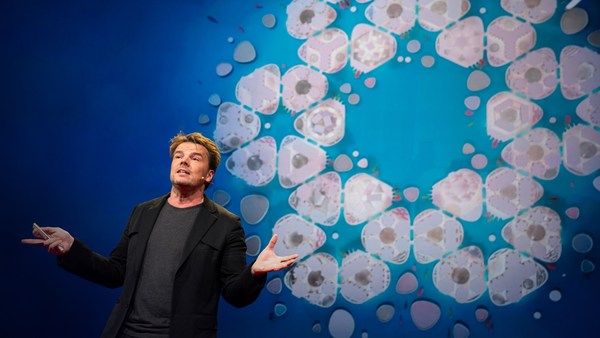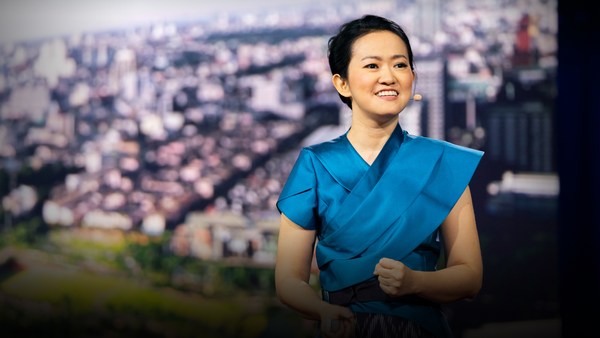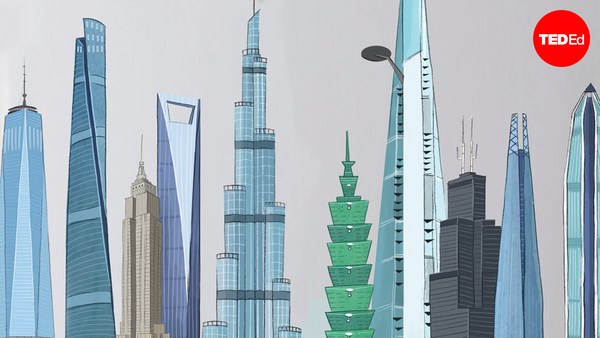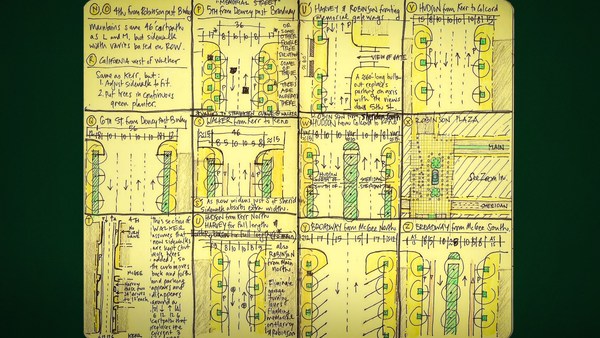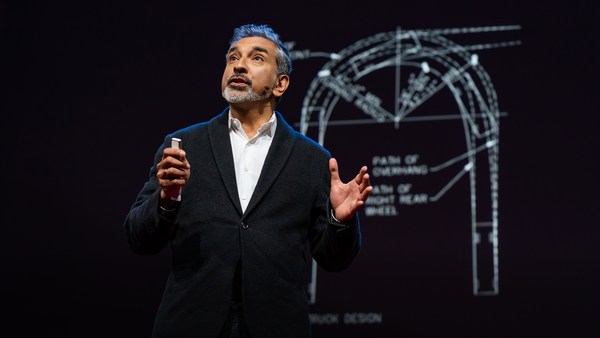On this planet today, there are about 50 cities that are larger than five million people. I'm going to share with you the story of one such city, a city of seven million people, but a city that's a temporary megacity, an ephemeral megacity. This is a city that is built for a Hindu religious festival called Kumbh Mela, which occurs every 12 years, in smaller editions every four years, and takes place at the confluence of the Ganges and the Yamuna rivers in India. And for this festival, about 100 million people congregate.
The reason so many people congregate here, is the Hindus believe that during the festival, the cycle every 12 years, if you bathe at the confluence of these two great rivers you are freed from rebirth. It's a really compelling idea, you are liberated from life as we know it. And this is what attracts these millions. And an entire megacity is built to house them. Seven million people live there for the 55 days, and the other 100 million visit.
These are images from the same spot that we took over the 10 weeks that it takes for the city to emerge. After the monsoon, as the waters of these rivers begin to recede and the sand banks expose themselves, it becomes the terrain for the city. And by the 15th of January, starting 15th of October to 15th of January, in these weeks an entire city emerges. A city that houses seven million people.
What is fascinating is this city actually has all the characteristics of a real megacity: a grid is employed to lay the city out. The urban system is a grid and every street on this city goes across the river on a pontoon bridge. Incredibly resilient, because if there's an unseasonal downpour or if the river changes course, the urban system stays intact, the city adjusts itself to this terrain which can be volatile. It also replicates all forms of physical, as well as social, infrastructure. Water supply, sewage, electricity, there are 1,400 CCTV cameras that are used for security by an entire station that is set up. But also social infrastructure, like clinics, hospitals, all sorts of community services, that make this function like any real megacity would do. 10,500 sweepers are employed by the city. It has a governance system, a Mela Adhikari, or the commissioner of the festival, that ensures that land is allocated, there are systems for all of this, that the system of the city, the mobility, all works efficiently. You know, it was the cleanest and the most efficient Indian city I've lived in.
(Laughter)
And that's what it looks like in comparison to Manhattan, 30 square kilometers, that's the scale of the city.
And this is not an informal city or a pop-up city. This is a formal city, this is a state enterprise, the government sets this up. In today's world of neoliberalism and capitalism, where the state has devolved itself complete responsibility from making and designing cities, this is an incredible case. It's a deliberate, intentional city, a formal city.
And it's a city that sits on the ground very lightly. It sits on the banks of these rivers. And it leaves very little mark. There are no foundations; fabric is used to build this entire city. What's also quite incredible is that there are five materials that are used to build this settlement for seven million people: eight-foot tall bamboo, string or rope, nails or screw and a skinning material. Could be corrugated metal, a fabric or plastic. And these materials come together and aggregate. It's like a kit of parts. And it's used all the way from a small tent, which might house five or six people, or a family, to temples that can house 500, sometimes 1,000 people. And this kit of parts, and this imagination of the city, allows it to be disassembled. And so at the end of the festival, within a week, the entire city is disassembled. These are again images from the same spot. And the terrain is offered back to the river, as with the monsoon the water swells again. And it's this sort of imagination as a kit of parts that allows this disassembly and the reabsorption of all this material. So the electricity poles go to little villages in the hinterland, the pontoon bridges are used in small towns, the material is all reabsorbed. Fascinating, it's amazing.
Now, you may embrace these Hindu beliefs or not. But you know, this is a stunning example, and it's worthy of reflection. Here, human beings spend an enormous amount of energy and imagination knowing that the city is going to reverse, it's going to be disassembled, it's going to disappear, it's the ephemeral megacity. And it has profound lessons to teach us. Lessons about how to touch the ground lightly, about reversibility, about disassembly. Rather amazing.
And you know, we are, as humans, obsessed with permanence. We resist change. It's an impulse that we all have. And we resist change in spite of the fact that change is perhaps the only constant in our lives. Everything has an expiry date, including Spaceship Earth, our planet.
So what can we learn from these sorts of settlements? Burning Man, of course much smaller, but reversible. Or the thousands of markets for transaction, that appear around the globe in Asia, Latin America, Africa, this one in Mexico, where the parking lots are animated on the weekends, about 50,000 vendors, but on a temporal cycle. The farmer's market in the Americas: it's an amazing phenomenon, creates new chemistries, extends the margin of space that is unused or not used optimally, like parking lots, for example.
In my own city of Mumbai, where I practice as an architect and a planner, I see this in the everyday landscape. I call this the Kinetic City. It twitches like a live organism; it's not static. It changes every day, on sometimes predictable cycles. About six million people live in these kinds of temporary settlements. Like -- unfortunately, like refugee camps, the slums of Mumbai, the favelas of Latin America. Here, the temporary is becoming the new permanent. Here, urbanism is not about grand vision, it's about grand adjustment.
On the street in Mumbai, during the Ganesh festival, a transformation. A community hall is created for 10 days. Bollywood films are shown, thousands congregate for dinners and celebration. It's made out of paper-mache and plaster of Paris. Designed to be disassembled, and in 10 days, overnight, it disappears, and the street goes back to anonymity. Or our wonderful open spaces, we call them maidans. And it's used for this incredibly nuanced and complicated, fascinating Indian game, called cricket, which, I believe, the British invented.
(Laughter)
And in the evenings, a wedding wraps around the cricket pitch -- Notice, the cricket pitch is not touched, it's sacred ground.
(Laughter)
But here, the club members and the wedding party partake in tea through a common kitchen. And at midnight, it's disassembled, and the space offered back to the city. Here, urbanism is an elastic condition.
And so, if we reflect about these questions, I mean, I think many come to mind. But an important one is, are we really, in our cities, in our imagination about urbanism, making permanent solutions for temporary problems? Are we locking resources into paradigms that we don't even know will be relevant in a decade? This becomes, I think, an interesting question that arises from this research.
I mean, look at the abandoned shopping malls in North America, suburban North America. Retail experts have predicted that in the next decade, of the 2,000 malls that exist today, 50 percent will be abandoned. Massive amount of material, capturing resources, that will not be relevant soon.
Or the Olympic stadiums. Around the globe, cities build these under great contestation with massive resources, but after the games go, they can't often get absorbed into the city. Couldn't these be nomadic structures, deflatable, we have the technology for that, that get gifted to smaller towns around the world or in those countries, or are stored and moved for the next Olympics? A massive, inefficient use of resources.
Like the circus. I mean, we could imagine it like the circus, this wonderful institution that used to camp in cities, set up this lovely kind of visual dialogue with the static city. And within it, the amazement. Children of different ethnic groups become suddenly aware of each other, people of color become aware of others, income groups and cultures and ethnicities all come together around the amazement of the ring with animals and performers. New chemistries are created, people become aware of things, and this moves on to the next town. Or nature, the fluxes of nature, climate change, how do we deal with this, can we be more accommodating? Can we create softer urban systems? Or are we going to challenge nature continuously with heavy infrastructure, which we are already doing, unsuccessfully?
Now, I'm not arguing that we've got to make our cities like a circus, I'm not arguing that cities must be completely temporary. I'm only making a plea that we need to make a shift in our imagination about cities, where we need to reserve more space for uses on a temporal scale. Where we need to use our resources efficiently, to extend the expiry date of our planet. We need to change planning urban design cultures, to think of the temporal, the reversible, the disassembleable. And that can be tremendous in terms of the effect it might have on our lives.
I often think back to the Kumbh Mela that I visited with my students and I studied, and this was a moment where the city had been disassembled. A week after the festival was over. There was no mark. The terrain was waiting to be covered over by the water, to be consumed. And I went to thank a high priestess who had helped us and my students through our research and facilitated us through this process. And I went to her with great enthusiasm, and I told her about how much we had learned about infrastructure, the city, the efficiency of the city, the architecture, the five materials that made the city. She looked really amused, she was smiling. In any case, she leaned forward and put her hand on my head to bless me. And she whispered in my ear, she said, "Feel blessed that the Mother Ganges allowed you all to sit in her lap for a few days."
I've often thought about this, and of course, I understood what she said. She said, cities, people, architecture will come and go, but the planet is here to stay. Touch it lightly, leave a minimal mark. And I think that's an important lesson for us as citizens and architects. And I think it was this experience that made me believe that impermanence is bigger than permanence and bigger than us all.
Thank you for listening.
(Applause)
